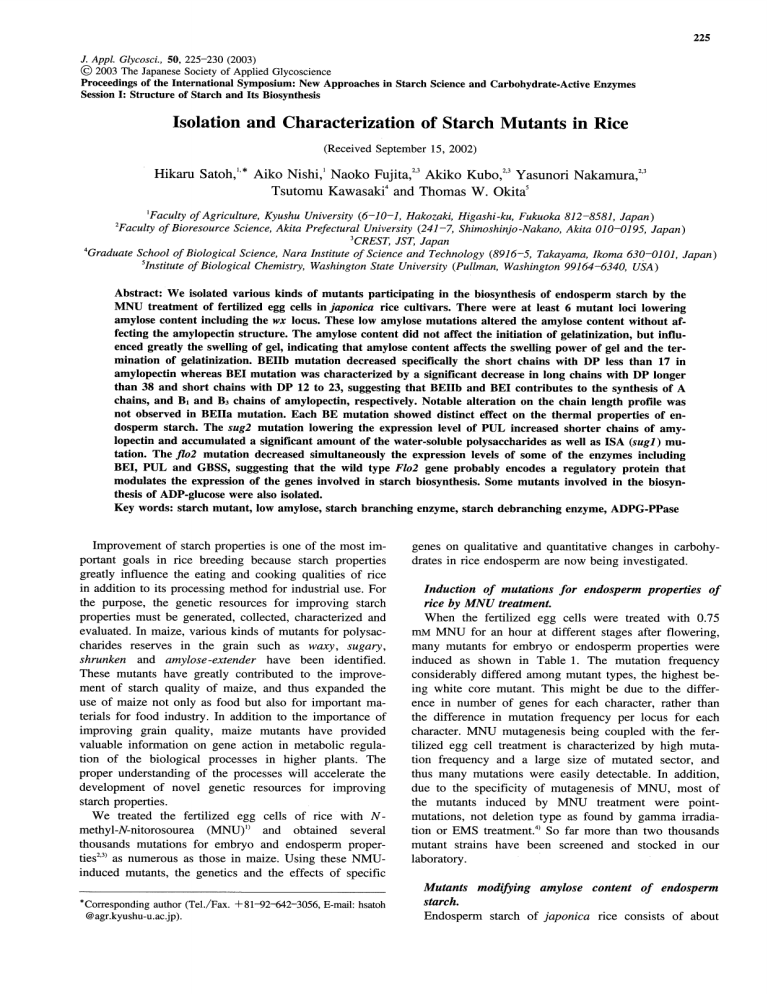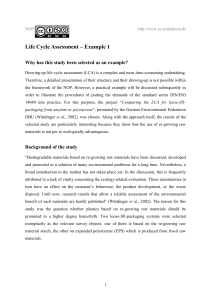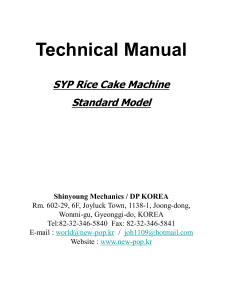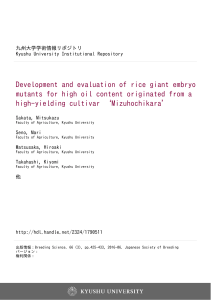
225 J. Appl. Glycosci., 50, 225-230 (2003) © 2003 The Japanese Society of Applied Glycoscience Proceedings of the International Symposium: New Approaches in Starch Science and Carbohydrate-Active Enzymes Session I: Structure of Starch and Its Biosynthesis Isolation and Characterization of Starch (Received September Mutants in Rice 15, 2002) Hikaru Satoh,1,*Aiko Nishi,1 Naoko Fujita,2,3Akiko Kubo,2,3Yasunori Nakamura,2,3 Tsutomu Kawasaki4 and Thomas W. Okita5 1 Faculty of Agriculture, Kyushu University (6-10-1, Hakozaki, Higashi-ku, Fukuoka 812-8581, Japan )2Faculty of Bioresource Science , Akita Prefectural University (241-7, Shimoshinjo-Nakano, Akita 010-0195, Japan) 3CREST, JST, Japan 4Graduate School of Biological Science , Nara Institute of Science and Technology (8916-5, Takayama, Ikoma 630-0101, Japan) 5nstitute of Biological Chemistry, Washington State University (Pullman, Washington 99164-6340, USA) Abstract: We isolated various kinds of mutants participating in the biosynthesis of endosperm starch by the MNU treatment of fertilized egg cells in japonica rice cultivars. There were at least 6 mutant loci lowering amylose content including the wx locus. These low amylose mutations altered the amylose content without af fecting the amylopectin structure. The amylose content did not affect the initiation of gelatinization, but influ enced greatly the swelling of gel, indicating that amylose content affects the swelling power of gel and the termination of gelatinization. BEIIb mutation decreased specifically the short chains with DP less than 17 in amylopectin whereas BEI mutation was characterized by a significant decrease in long chains with DP longer than 38 and short chains with DP 12 to 23, suggesting that BEIIb and BEI contributes to the synthesis of A chains, and B, and B3 chains of amylopectin, respectively. Notable alteration on the chain length profile was not observed in BEIIa mutation. Each BE mutation showed distinct effect on the thermal properties of en dosperm starch. The sug2 mutation lowering the expression level of PUL increased shorter chains of amy lopectin and accumulated a significant amount of the water-soluble polysaccharides as well as ISA (sugl ) mu tation. The fl o2 mutation decreased simultaneously the expression levels of some of the enzymes including BE!, PUL and GBSS, suggesting that the wild type Flo2 gene probably encodes a regulatory protein that modulates the expression of the genes involved in starch biosynthesis. Some mutants involved in the biosyn thesis of ADP-glucose were also isolated. Key words: starch mutant, low amylose, starch branching enzyme, starch debranching enzyme, ADPGPPase Improvement of starch properties is one of the most important goals in greatly influence in addition to its the purpose, the rice breeding because starch properties the eating and cooking qualities of rice processing method for industrial use. For genetic resources for improving starch properties must be generated, collected, characterized and evaluated. In maize, various kinds of mutants for polysaccharides reserves in the grain such as waxy, sugary, shrunken and amylose-extender have been identified. These mutants have greatly contributed to the improvement of starch quality of maize, and thus expanded the use of maize not only as food but also for important materials for food industry. In addition to the importance of improving grain quality, maize mutants have provided valuable information on gene action in metabolic regulation of the biological processes in higher plants. The proper understanding of the processes will accelerate the development of novel genetic resources for improving starch properties. We treated the fertilized egg cells of rice with Nmethyl-N nitorosourea (MNU)1) and obtained several thousands mutations for embryo and endosperm properties2'3' as numerous as those in maize. Using these NMUinduced mutants, the genetics and the effects of specific *Corresponding author (Tel ./Fax. + 81-92--642-3056, E-mail: hsatoh @agr.kyushu-u.ac.jp). genes on qualitative and quantitative changes in carbohydrates in rice endosperm are now being investigated. Induction of mutations for endosperm properties of rice by MNU treatment. When the fertilized egg cells were treated with 0.75 mM MNU for an hour at different stages after flowering, many mutants for embryo or endosperm properties were induced as shown in Table 1. The mutation frequency considerably differed among mutant types, the highest being white core mutant. This might be due to the difference in number of genes for each character, rather than the difference in mutation frequency per locus for each character. MNU mutagenesis being coupled with the fertilized egg cell treatment is characterized by high mutation frequency and a large size of mutated sector, and thus many mutations were easily detectable. In addition, due to the specificity of mutagenesis of MNU, most of the mutants induced by MNU treatment were pointmutations, not deletion type as found by gamma irradiation or EMS treatment.4)So far more than two thousands mutant strains have been screened and stocked in our laboratory. Mutants modifying amylose content of endosperm starch. Endosperm starch of japonica rice consists of about J. Appl. Glycosci., Vol. 50, No. 2 (2003) 226 20% to amylose and amylopectin properties After of cooked treatment of mutants with fine classified amount of In amylose in type was white. was mutants tween starches stained light had hazy white waxy rice which Amylose lines were ranging dull the non-waxy between the wx ing of in from mutants phenotype locus, amylose 3.2% were and dull waxy and five other contents Table amylose non-waxy solution, The there content. loci endosperm 1. Spectra bemutant iodine or solu- waxy among rice. mutant phenotypes of between of wx (dull) dull the varied gene wildlooked of The non-waxy and deficiency intermediate intermediate rice, wild- amylose by 12.8%. no higher of 12-KI rice. mutants to also the the low purple from char- mutants the non-waxy distinct percentage the The reddish were had starch with endosperm, and stained to They or to maize wx endosperm brown. 2). endosperm the blue-black normal little which due The many with relative wild-type the turned physical (Table in and Although were tion, the amylose MNU, but type, mutation translucent, counterpart starch (du) synthase ‡V.5 of the containing content dull than type dull amylose the starch rice snow rice lower with obtained (wx) and content soluble cells content were waxy ratio profoundly egg structure contrast, The affect amylose into by type. to rice. fertilized amylose, acterized amylopectin. modified amylopectin were 80% is known was a In involved all of correlation addition in starch those the lower- have and frequencies to been of endosperm identified in rice.6 ) The gelatinization pattern of endosperm starch in urea solutions of varying concentrations was significantly different among waxy, dull and non-waxy rice. Although the initiation of starch gelatinization was almost the same in all mutants, the termination of gelatinization was apparently distinct among them and increased in positively correlated with the amylose content. The swelling of endosperm starch from both waxy and non-waxy rice exhibited a biphasic response with increases in urea concentration. However, the extent of swelling at a given concentration of urea was more significant in waxy starch than in non-waxy starch. The results of gelatinization pattern in urea solution showed that the amylose content does not affect the initiation of gelatinization, but influences greatly the swelling of gel, indicating that amylose content affects the swelling power of gel and the termination of gelatinization. There was little difference in the initiation temperature of thermal gelatinization of endosperm starch among waxy, dull and non-waxy rice, although it was slightly lower in waxy mutants than in non-waxy rice. However, the termination temperature of gelatinization of endosperm starch remarkably differed. With increasing amylose content, the termination temperature of gelatinization shifted to high temperature as found in urea gelatinization. As mentioned above, amylopectin fine structure was not almutations induced by MNU treatment in rice. Starch Mutants tered by these mutations. These results suggest that amylopectin, the major component of starch, plays an important role for the initiation of gelatinization, whereas amylose contributes to the termination temperature. Most of the waxy mutants induced by the MNU treatment were deficient in GBSSI, indicating that the lack of amylose in the starches of waxy mutants is most likely due to the deficiency in GBSSI. Some of the waxy mutants, the missense mutation of GBSSI gene, exhibited normal levels of GBSSI. Expression level of GBSSI in waxy or dull mutants with low amylose content correlated well with amylose content, implying that GBSSI is responsible for amylose synthesis. However, the presence of various mutant genes that lowered amylose content suggests that there is a complex mechanism for the genetic regulation of amylose synthesis in rice. Recently, Issiki et al .7)reported that dull mutations are involved in the splicing of mRNA of the Wxbgene. The amylose content of endosperm starch greatly affects the cooking and eating qualities of milled rice, low amylose varieties being more palatable than high amylose ones, especially in japonica rice. Low amylose mutants obtained with MNU treatment would be useful in the imppovement of palatability of rice. Mutants affecting the biosynthesis of amylopectin. Amylopectin is a highly branched molecule with a-1,6glucosidic bond and makes up about 80% of endosperm starch in rice. The enzymatic mechanism of amylopectin synthesis can be considered to involve four processes: initiation, chain elongation, branching and debranching. These processes are catalyzed by 1) ADP-glucose pyrophosphorylase, 2) starch synthase, 3) starch branching enzyme and 4) starch debranching enzyme, respectively. Various kinds of mutants for amylopectin biosynthesis were recently found in maize, pea and Chlamydomonas. We have also isolated various kinds of MNU-induced rice mutants with modified amylopectin. Three isoforms of branching enzyme-BET, BEITa and BEIIb were observed in rice endosperm.8)9)Although the amylose-extender (ae) mutant which is deficient in BEIIb, were obtained by MNU treatment,10-12) we recently isolated mutants for the other two isoforms of BE, i.e., a mutant lacking in BET activity and a mutant with a remarkable decrease in BEIIa activity (Fig. 1). All of the BE mutants were controlled by respective single genes. Genetic analysis using respective cDNA probes indicated that they are mutants of genes encoding the BET and BEIIa, respectively, and tentatively designated sbe 1 and sbe 2, respectively. The grains of the BEIIb-deficient ae mutant were markedly smaller than those of the wild-type, and the dry weight was 65% of the wild-type. In addition, the grains were usually floury in appearance. Interestingly, the endosperm of BET mutant exhibited the normal phenotype and contained an amount of starch comparable with the wild-type. However, the mutation apparently altered the fine structure of amylopectin. The same tendency was observed in the BEIIa mutation. The a-1,4 chains of amylopectin consist of A chains that carry no additional chains, B chains that carry A in Rice 227 chains or other B chains, and a C chain that includes the reducing terminus.13) Hizukuri14) proposed a cluster model for amylopectin. In this model, A and B, chains form a single cluster, while B2 and B3 chains extend to two and three clusters, respectively. Hanashiro et al.)S) proposed that, in amylopectin, chains of DP 12, 13 s DP s 24, 25 DP s 36 and DP 37 correspond to A chains, B, chains, B2 chains, and B3 and longer chains, respectively. The profiles of chain length distribution were significantly different among BE mutations (Fig. 2). BEIIb (ae ) mutation decreased specifically the short chains with DP less than 17, suggesting that the BEIIb contributes to the synthesis of A chains of amylopectin. In contrast, the amylopectin of BET deficient mutant (sbel ) was characterized by a significant decrease in long chains with DP longer than 38 and short chains with DP 12 to 23, and a increase in short chains with shorter than DP 11 and in intermediate chains with DP 24 to 35. This suggests that BEI specifically synthesizes B, chains as well as B3 chains. However, notable alteration on the profile of chain length distribution was not observed in BEIIa (sbe2) mutation. The structure of amylopectin is characterized by the fact that a unit structure with a constant size throughout the plant kingdom called cluster is tandem linked,16" ) and the distinct structure may be referred to as "tandemcluster structure. " It has been documented that the individual cluster has the amorphous region and the crystalline region, and branches are distributed in the both regions.)8"9) In the rice BE mutants, the loss of BE activity leads to poor efficiency in producing unit-chain (branches) of amylopectin. Based on these observations, it is reasonable to assume that BEs should produce three different types of branches in terms of these contributions to the amylopectin structure; those formed in the amorphous region and the crystalline region of the cluster, and those linking the clusters.20) The effects of urea concentrations from 0 to 9 M on the gelatinization of starch granules were distinctively observed in three kinds of BE mutants. The starch from mature endosperm of the wild-type started to gelatinize between 3 and 4 M urea solution. By contrast, endosperm starch granules from the ae mutant hardly gelatinized in urea solution up to 7 M, but began to gelatinize at 8 M. The starch granules from the amylose-free ae/wx double mutant, which consisted exclusively of ae-type amylopectin, also gelatinized in 8 M urea. These results indicate that the starting concentration of urea for gelatinization of endosperm starch granules depends on the structure of the amylopectin rather than on the level or structure of amylose. On the contrary, the sbel mutant starch exhibited a slightly lower concentration of urea for onset gelatinization and a higher swelling mode as compared with the wild-type starch. The endosperm starch from the sbe2 mutant exhibited little difference with the wild-type on the concentration of urea for onset gelatinization. Each BE mutation showed distinct effect on the thermal properties of endosperm starch (Table 3). While BEIIbdeficient ae starch exhibited extremely higher onset gelatinization temperature, the sbel starch was characterized by a lower onset temperature for thermo-gelatinization and a significantly lower enthalpy. These results indicate 228 Table J. Appl. Glycosci., 3. Thermal properties of starch from endosperms three kinds of rice BE mutants as measured DSC. Vol. 50, No. 2 (2003) of by Fig. 3. Effect of sugary mutations on chain length amylopectin in rice endosperm. distribution of The figures compare the chain profiles of total polyglucans between sugary I and sugary 2 mutants and their parent cultivars, Taichung 65 and Kinmaze, respectively. Fig. 1. SDS-PAGE and Native-PAGE/activity staining analyses of enzymes involved in starch biosynthesis in three kinds of BE mutants of rice. A) SDS-PAGE of enzymes in mature rice seed. B) NativePAGE/activity staining of BEs in developing rice seed. Fig. 4. SDS-PAGE and native-PAGE/activity staining analyses of enzymes involving in starch biosynthesis in developing seeds of _floury 2 mutant in rice. A) SDS-PAGE of enzymes in mature seed. B) Native-PAGE/activity staining of BEs in developing seed. Fig. 5. Effect of floury 2 mutation on chain length distribution of amylopectin in rice endosperm. The figures compare the chain length profiles of amylopectins between the mutant (EM36) and its parent cultivars Kinmaze. that the genetic modification of amylopectin fine structure is responsible for changes in physicochemical properties of starch. The BEIIa mutant starch had the highest enthalpy, though no significant alteration in the chain length distribution of amylopectin was found (Fig. 2), suggesting that a-1,6 branches produced by BElla also affect the ultra-structure of amylopectin. Two kinds of debranching enzymes-isoamylase and Fig. 2. Effect of BE mutations on chain length distribution of amylopectin in rice endosperm. The figures show differences in chain length profiles of amylopectins between the respective mutants and their parent cultivars, Taichung 65 (for sbel mutant) and Kinmaze (for ae and sbe2 mutants) (japonica -type rice). pullulanase are found in endosperm cell of rice.21)wo kinds of non-allelic sugary mutant which are named as sugary I (sugl )22)and sugary 2 (sug2), respectively, have been identified in rice. Endosperm starch of sugl mutants is characterized by the higher content of the water soluble polysaccharide phytoglycogen having less amount of amylopectin.2'.24' Kubo et a1.2" reported that sugl mutation in rice is lesion of the isoamylase gene and it causes the remarkable reduction of pullulanase activity. Preliminary experiment indicated that sug2 mutation also significantly Starch Fig. 6. Schematic representation of the metabolic pathways Mutants and putative in Rice sites of mutations 229 in starch biosynthesis of rice endosperm. 1, invertase; 2, hexokinase; 3, hexose-6-phosphatase; 4, P-hexoseisomerase; 5, cytosolic P-glucomutase; 6, sucrose synthase; 7, UDPGIcPPase; 8, cytosolic ADPglucose pyrophosphorylase; 9, plastidial P-glucomutase; 10, plastidial ADPglucose pyrophosphorylase; 11, plastidial starch phosphorylase. ADPG, ADPglucose; UDPG, UDPglucose. reduced the expression level of pullulanase in endosperm. Figure 3 shows the effects of sugl and sug2 mutations on the chain length distribution of amylopectin. The sug] mutation accumulated phytoglycogen instead of starch. In phytoglycogen, the number of A chains dramatically increased, while long B chains with less than DP 37 remarkably decreased or were almost absent, which resulted in the disappearance of the cluster structure .21)The sug2 mutation accumulated a significant amount of the water soluble polysaccharides. Both sugary mutations increased short chains and decreased long chains. So far, five strains of sug2 mutants were isolated by independent MNU treatment. The expression level of pullulanase was decreased in all sug2 mutants. Mutants lacking in this enzyme has not been isolated. Genetic analysis suggested that sug2 gene is not in chromosome 4 where a gene encoding pullulanase is located26) implying that sug2 gene might participate in the regulation of pullulanase, but not encode this enzyme. An interesting mutation floury 2 (flo2) was found in rice. Western blot analysis showed that the BEI level was greatly reduced to almost 10% of the wild-type in the mature seeds of the flo2 mutants.2" Interestingly, the production of BEIIb, SSSI, GBSS, PUL and starch phosphorylase was also reduced (Fig. 4). We also found that the expression levels of BEIIb, GBSS and PUL in the flo2 mutant corresponded to approximately 55, 80 and 35%, respectively, of those in the wild-type (data not shown). The flo2 locus and the genes encoding BEI, BEIlb and GBSS have been mapped on different chromosomes. Therefore, the wild type Flo2 gene probably encodes a regulatory protein that modulates the expression of the genes involved in starch synthesis, particularly BEI. Since the 11 flo2 mutants exhibited reduced levels of BEIIb, they were expected to contain a higher proportion of apparent amylose content in starch than that of the wild-type. On the contrary, these 11 mutants had a significantly decreased amylose content (9-11%), as compared with the wild-type (15%). The reduction of amylose content in endosperm starch of flo2 mutant is probably caused by the significant reduction of the expression level of GBSSI. The flo2 mutation also altered the fine structure of amylopectin (Fig. 5). The flo2 amylopectin was characterized by the significant decrease in long chains with longer than DP 36 and short chains with DP 9-20, and the increases markedly in short chains with shorter than DP 8 and slightly in intermediate chains with DP 21-35. The profile of chain length distribution in flo2 amylopectin was similar to that of BEI mutant. The mode of gelatinization of endosperm starch by urea was also modified by the flo2 mutation. The flo2 starch was resistant to urea solution relative to that of the wild-type starch. The swelling of flo2 starch was lower than that of the wild-type, although the amylose content was significantly lower than that of the wild-type. In spite of the low level of BEI gene expression in the mature endosperm of the flo2 mutants, the BEI gene was equally expressed in the leaves of the wild-type and flo2 mutants. These results imply that wild type Flog gene may co-regulate the expression of some of the genes participating in starch synthesis possibly in a developing specific manner of the seed. In addition to the mutants modifying the starch properties, some mutants involved in the biosynthesis of ADPglucose were isolated in rice as well as in maize 21,21,or pea."" Two types of the mutant, i.e., shrunken I (shrl ) and shrunken 2 (shr2) were isolated in rice.22)These mutants were characterized by the reduced amount of starch and the elevated amount of sugars. Multiple allelic mutants were observed in both types. Preliminary experiments showed that both mutants exhibited less than 20% of ADP-glucose pyrophosphorylase activity of wild-type. Western blot analysis using antibodies for maize ADPglucose pyrophophorylase large subunit and small subunit showed that the endosperm of shr2 mutant lacked the small subunit, suggesting that the shr2 mutation occurs in a gene for ADP-glucose pyrophophorylase small subunit. J. Appl. Glycosci., Vol. 50, No. 2 (2003) 230 By contrast, shrl mutants showed equal expression of both of ADP-glucose pyrophophorylase large subunit and small subunit. The detail mechanisms for the shrunken mutations await further investigation. Many kinds of mutant genes involving in the starch biosynthesis have been identified in rice (Fig. 6) as well as in maize, pea or Chlamydomonas .31' There are many questions to be resolved for the biosynthesis of starch, although the recent progress in understanding its genetic regulation is encouraging. The analysis of mutants affecting the starch-synthesizing enzyme will provide clues to clarify the in vivo function of the corresponding enzymes.20' These clues will be useful in the breeding of rice varieties having novel starch properties. 347 15) (1986). 1. Hanashiro, of the and length of performance 16) Res., 283, P.J. Jenkins, 151-159 ture in the sources. 17) 18) 19) S. structure of Marcel Dekker, Bertoft starch and A.M. distribution revealed by high Carbohydr. 417-420 K. its structural different 43, York, nature 223-239 pp. Koch: fea botanicall of amylopectin (2000). aspects. in AC. Eliasson, 347-429 Carbohydrates in ed., Vol. 74, in waxyrice (1996). Composition units. universal (1993). Function, New and A from non-random analytical and Donald: granules Res., Starch: Structure E. 45, the Carbohydr. Hizukuri: and starch On Food: periodic as (1996). Cameron Thompson: branching. A amylopectin chromatography. RE. Starch/Stake, D.B. S. Hizukuri: anionexchange of chains Carbohydr. Polym., 41, 121-132 (2000). 20) Y. Nakamura: system REFERENCES 21) 1) H. Satoh and T. Omura: Induction of mutation by the treat ment of fertilized egg cell with N-methyl-N-nitrosourea in rice. J. Fac. Agric. Kyushu Univ., 24, 165-174 (1979). 2) H. Satoh and T. Omura: New endosperm mutations induced by chemical mutagens in rice, Oryza sativa L. Jpn. 1. Breed., 31, 316-326 (1981). 3) H. Satoh: Genic mutations affecting endosperm properties in rice. Gamma Field Symp., 24, 17-37 (1985). 4) S. Neal: Mutagenesity of nitrosoamids and nitrosoamidines in microorganisms and plants. Mutat. Res., 32, 229-226 (1976). 5) M. Gao, J. Wanat, P.S. Stinard, MG. James and M. Myers: Characterization of dulll , a maize gene coding for a novel starch synthase. Plant Cell, 10, 399-412 (1998). 6) M. Yano, K. Okuno, H. Satoh and T. Omura: Chromosomal location of genes conditioning low amylose content of en dosperm starches in rice, Oryza sativa L. Theor. Appl. Genet., 76, 1.83-189 (1.988). 7) M. Issiki, M. Nakajima, H. Satoh and K. Shimamoto: dull: rice mutants with tissue-specific effects on the splicing of the waxy pre-mRNA. Plant J., 23, 451-460 (2000). 8) H. Yamanouchi and Y. Nakamura: Organ specificity of iso forms of starch branching enzyme (Q-enzyme) in rice. Plani Cell Physiol., 33, 985-991 (1992). 9) Y. Nakamura, T. Takeichi, K. Kawaguchi and H. Yamanouchi: Purification of two forms of starch branching enzyme (Qenzyme) from developing rice endosperm. Physiol. Plant., 84, 329-335 (1992). 10) M. Yano, K. Okuno, J. Kawakami, H. Satoh and T. Omura: High amylose mutants of rice, Oryza sativa L. Theor. Appl . Genet., 69, 253-257 (1985). 11) K. Mizuno, T. Kawasaki, H. Shimada, H. Satoh, E. Kobayashi, S. Okumura, Y. Arai and T. Baba: Alteration of the structural properties of starch components by the lack of an isoform of starch branching enzyme in rice seeds. J. Biol. Chem., 268, 19084-19091 (1993). l2) A. Nishi, Y. Nakamura, N. Tanaka and H. Satoh: Biochemical and genetic analysis of the effects of amylose-extender muta tion in rice endosperm. Plant Physiol., 127, 459-472 (2001) . 13) S. Peat, W.J. Whelan and G.J. Thomas: Evidence of multiple branching in waxy maize starch. J. Chem. Soc., 4546-4548 (1952). 14) S. Hizukuri: Polymodal distribution of the chain lengths of amylopectins, and its significance. Carbohydr. Res., 147, 342- J. Abe chain as a model A. Kubo, 23) tissue. N. pullulanase are Yano, Breed., 34, both 43-49 (2002). H. enzymes Satoh and Y. isoamylase amylopectin 123, metabolic endosperm 718-725 Matsuda, in the Rice and biosynthesis 399-409 in (1999). Satoh and T. mutants of rice, Omura: Oryza Gene T. Omura: analysis sativa L. of Jpn. J. (1984). Yano, shrunken dosperm 43, T. Physiol., H. of plants: Physiol., Harada, involved Isono, Y. in starch-debranching shrunken Matsuo, and Cell K. Plant Y. and T. Plant endosperm. sugary understanding biosynthesis Fujita, The M. a better amylopectin Nakamura: rice 22) Towards for H. Satoh mutants during the and genes on Effect of carbohydrates ripening period. Jpn. Umemoto, Y. Takahata, in structure in sugary rice J. Breed., 37, K. Komae, en 17-21 (1987). 24) Y. Nakamura, Amano T. and zyme H. activities rice Y. Nakamura, da and sugary-l Nakamura, T. chromosomal 218 (1996). effect Denyer, The maize (Zea C. 112, from 1634 (1992). A.M. Myers, progress crystal. toward Plant 12, rice 97, of the genes participating locus. Plant maize Physiol., Dunlap, T. form L.) CR. Barton, the L. brittle- pyrophospho Keeling and A.M. pyrophosphorylase endosperm is in extra-plastidual. Plant (1996). A.M Smith: regulatory The changes developing Morell, 122, rb in embryos. understanding Physiol., by (1990). P. ADPglucose Kishi- (1996). of 881-885 N. biosynthesis 89-96 Morell, Thorbjornsen, of starch ADPglucose 92, 209- Coordinated characterization endosperm Plant M.K. M. 199, Satoh, Baba: pul- cDNA Planta, H. Yano or Purification, in Summers, M. (R-enzyme T. de (1997). Kuboki, gene. Hara- starch endosperms 143-153 Physiol.,110, Molecular K. of in Y. endosperm: and P.S. Mastuda, enzyme Shimada, 779-785 and rylase Ogata, H. mays and J., N. Ichikawa major Hylton structural 31) on F. Smith: Plant N. Nieder: subunits. Physiol., 30) M. T. activities Mizuno, S. Danner, gene K. the Floury-2 and rylase 29) of rice rice. debranching Okumura, J. Preiss, 2 enzyme Plant., structure localization K. S. Yang en developing Physiol. between developing Kawasaki, regulation 28) in E. and debranching Shimamune, Umemoto, Starch from moto, of T. and the starch and ƒ¿-polyglucan mutants Sasaki: T. Correlation enzyme Y. T. starch mutations of biosynthesis. Kubo, Satoh: lulanase) 27) amylopectin A. H. of and sugary role of (1996). branching 26) by Possible in 491-498 Changes affected endosperm: (R-enzyme) 25) Satoh: mutation Plant MG. James and (2000). peas causes pyrophospho Physiol., biosynthesis 989-997 of ADPglucose S.G. of the 99, Ball: 1626- Recent amylopectin



